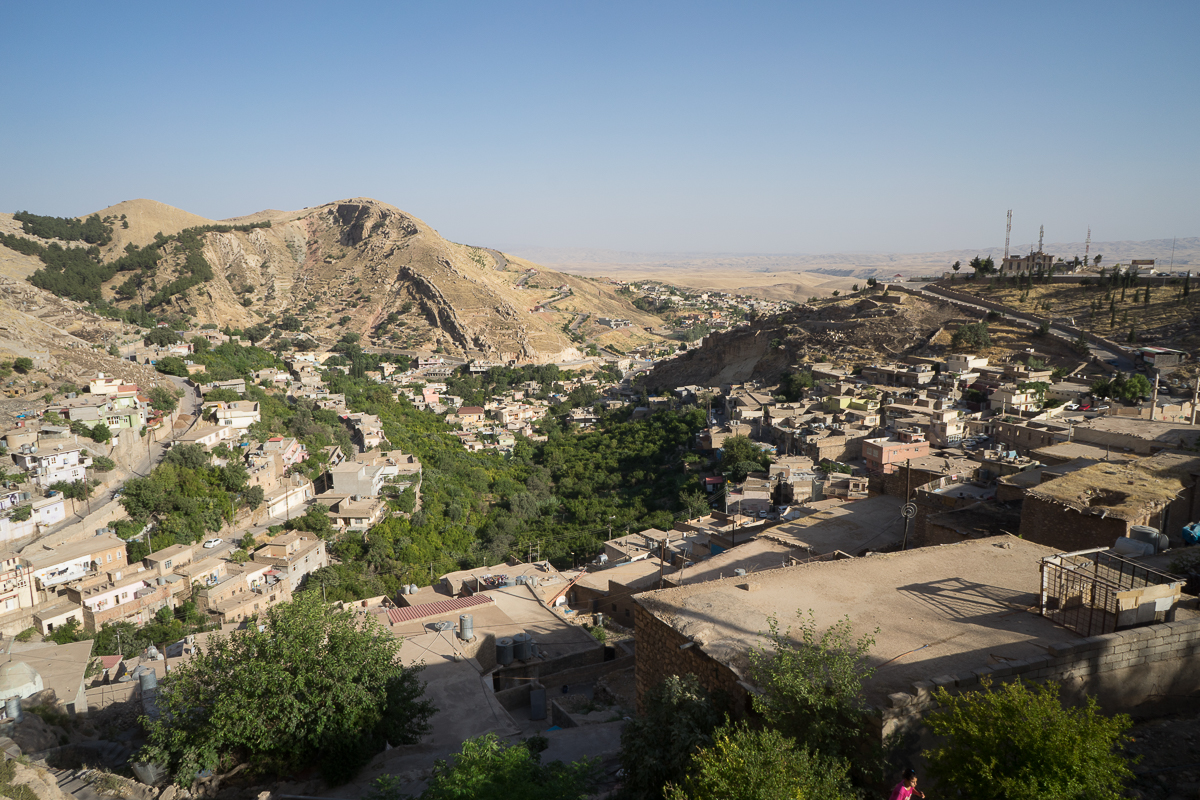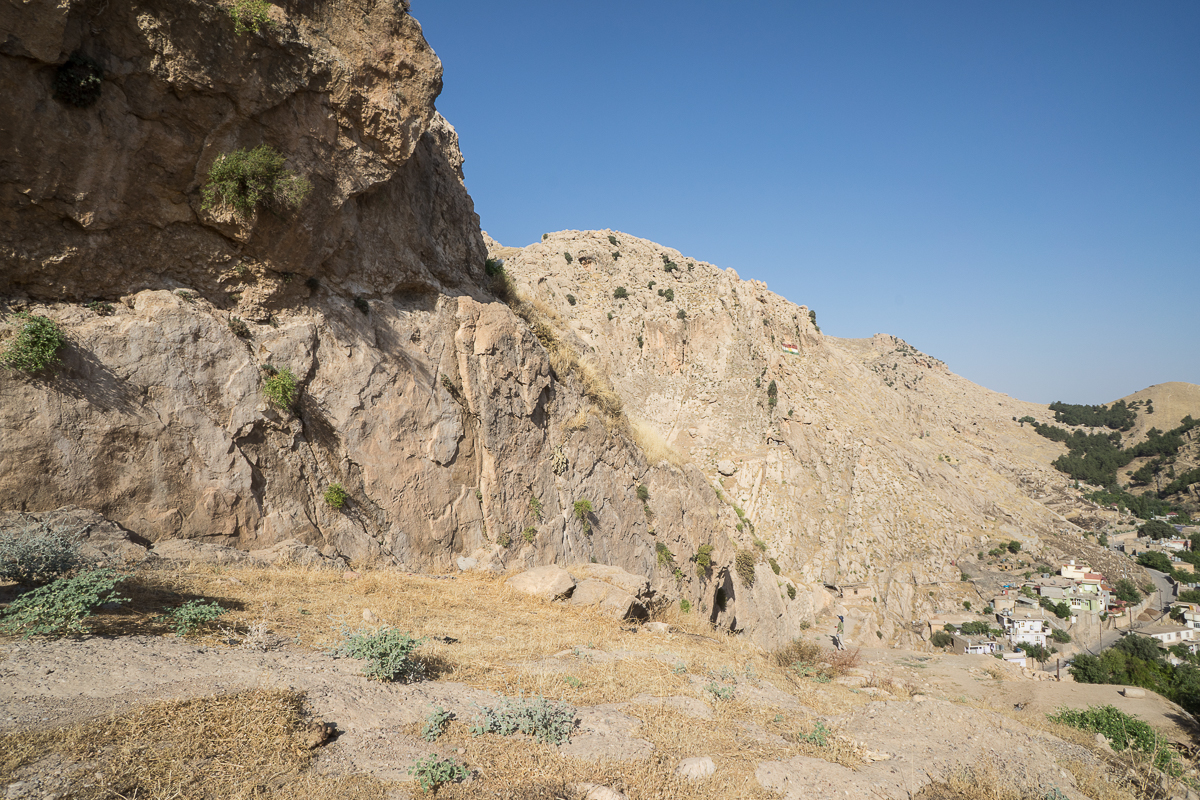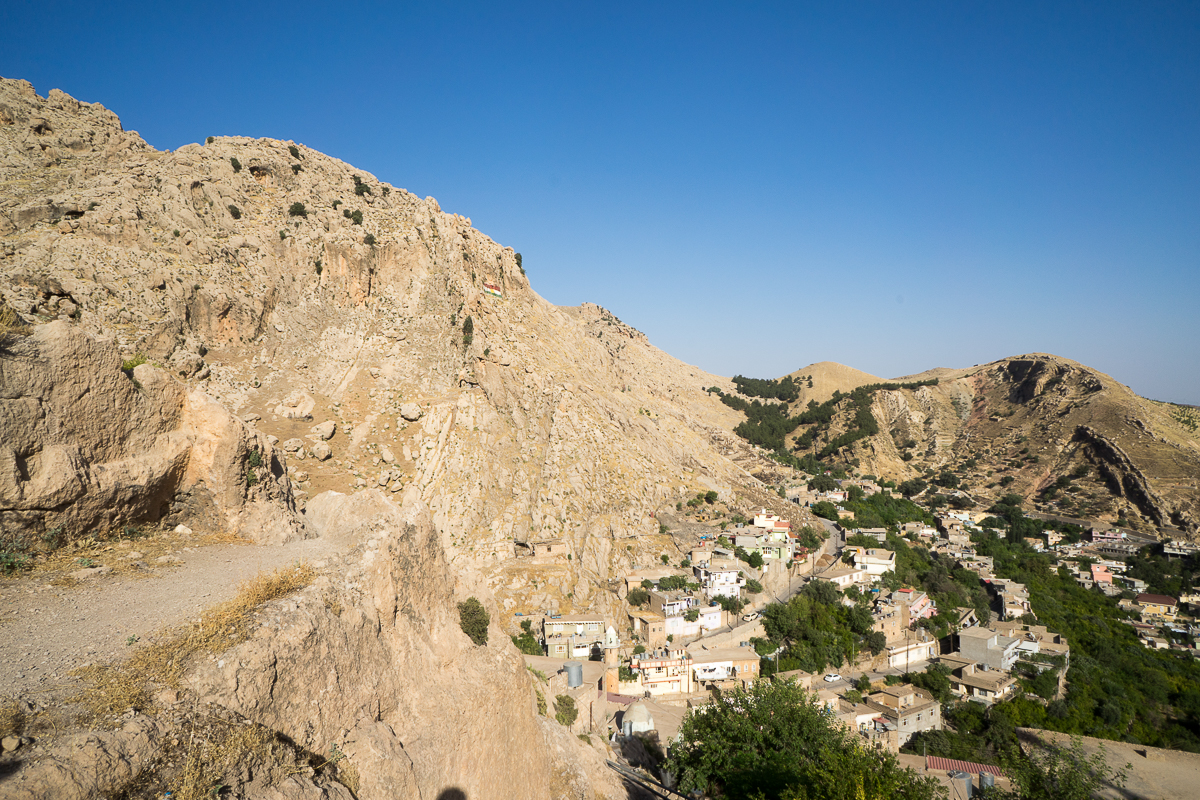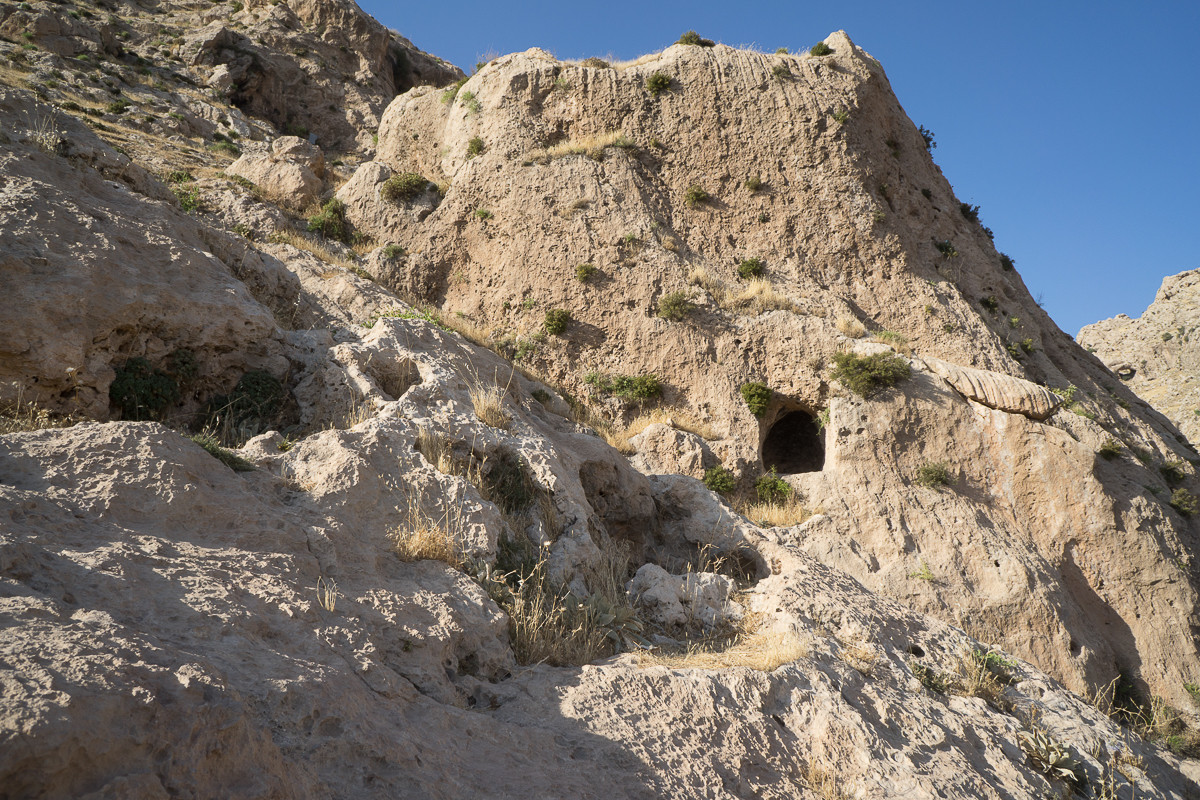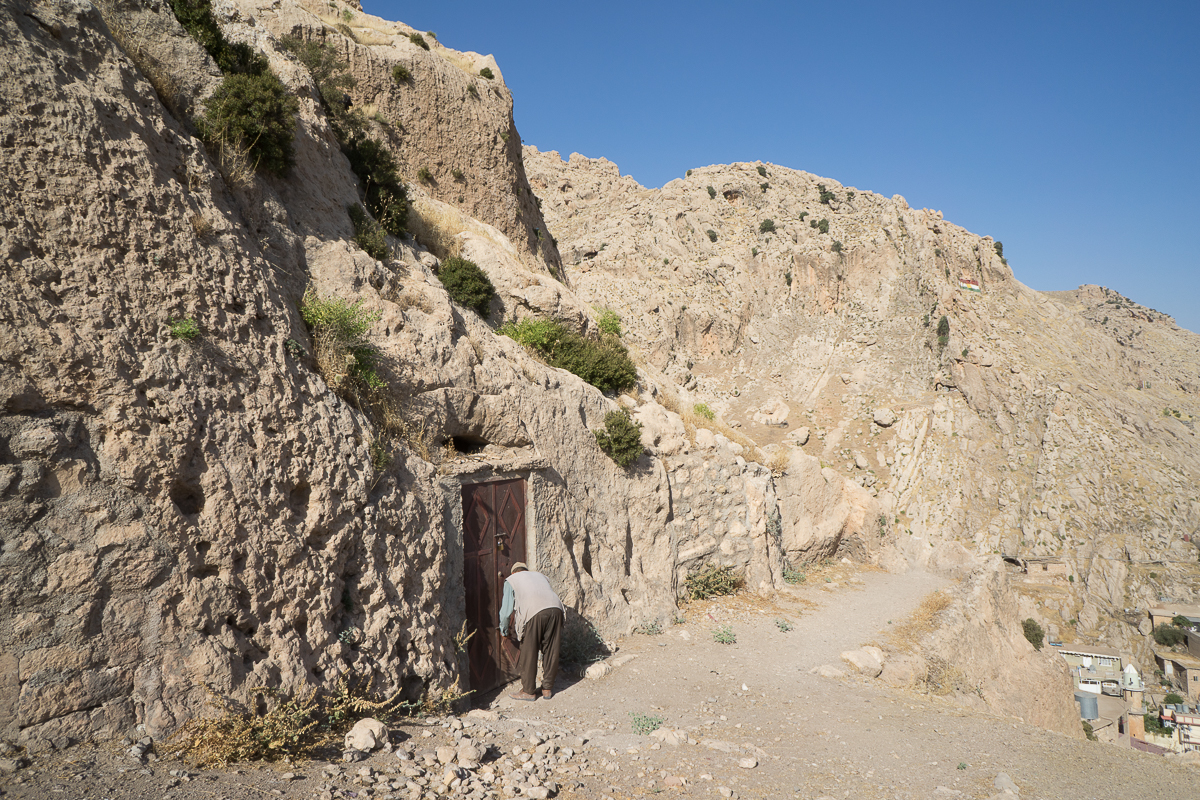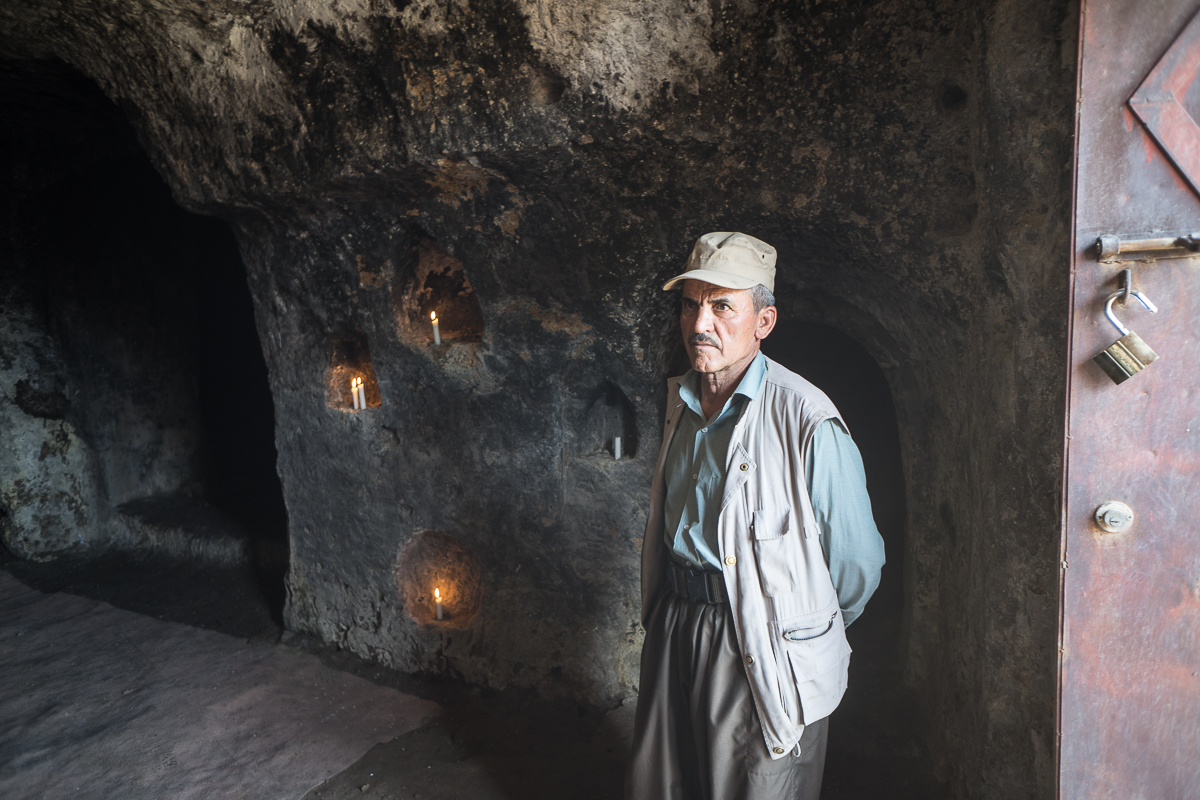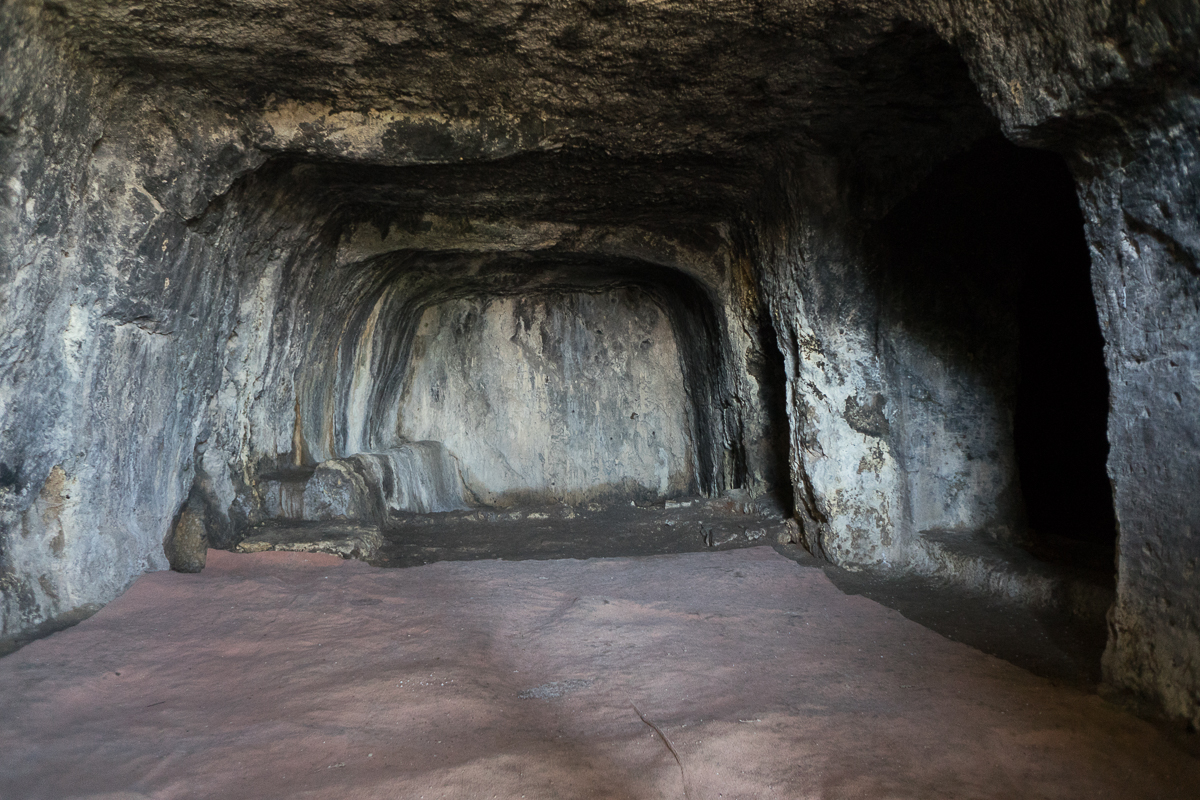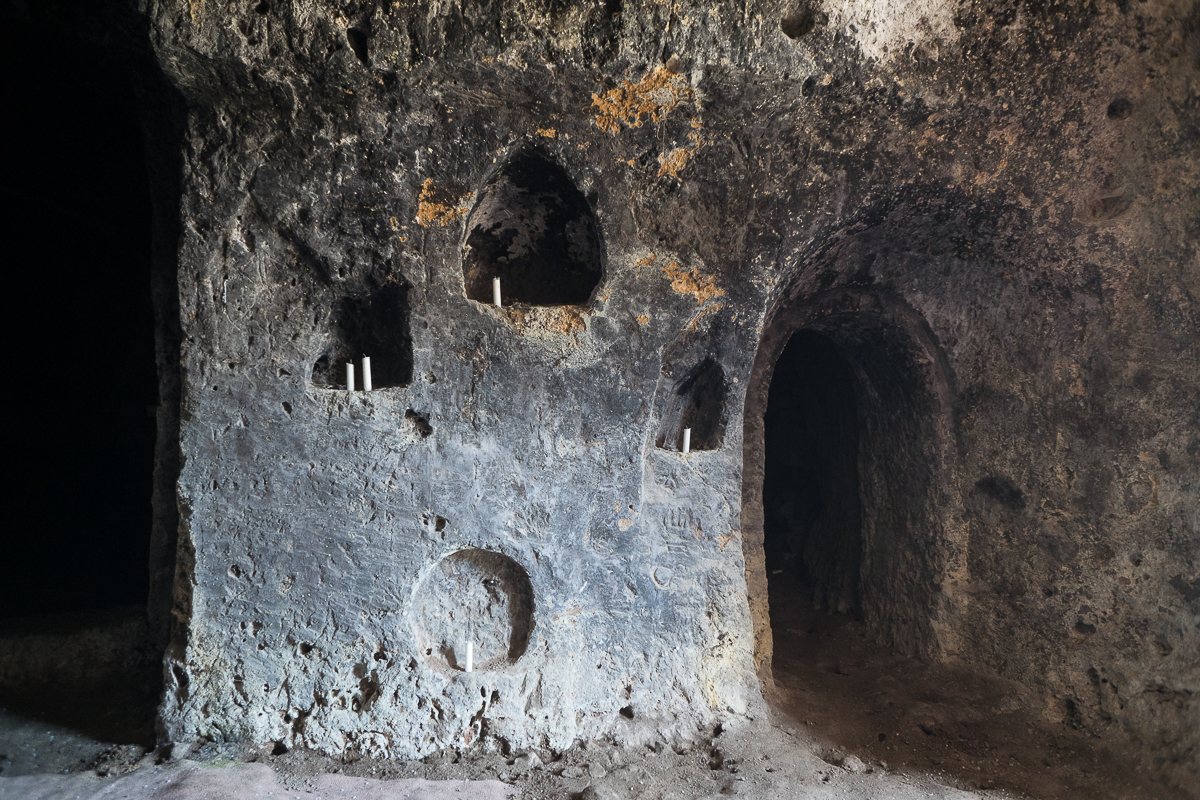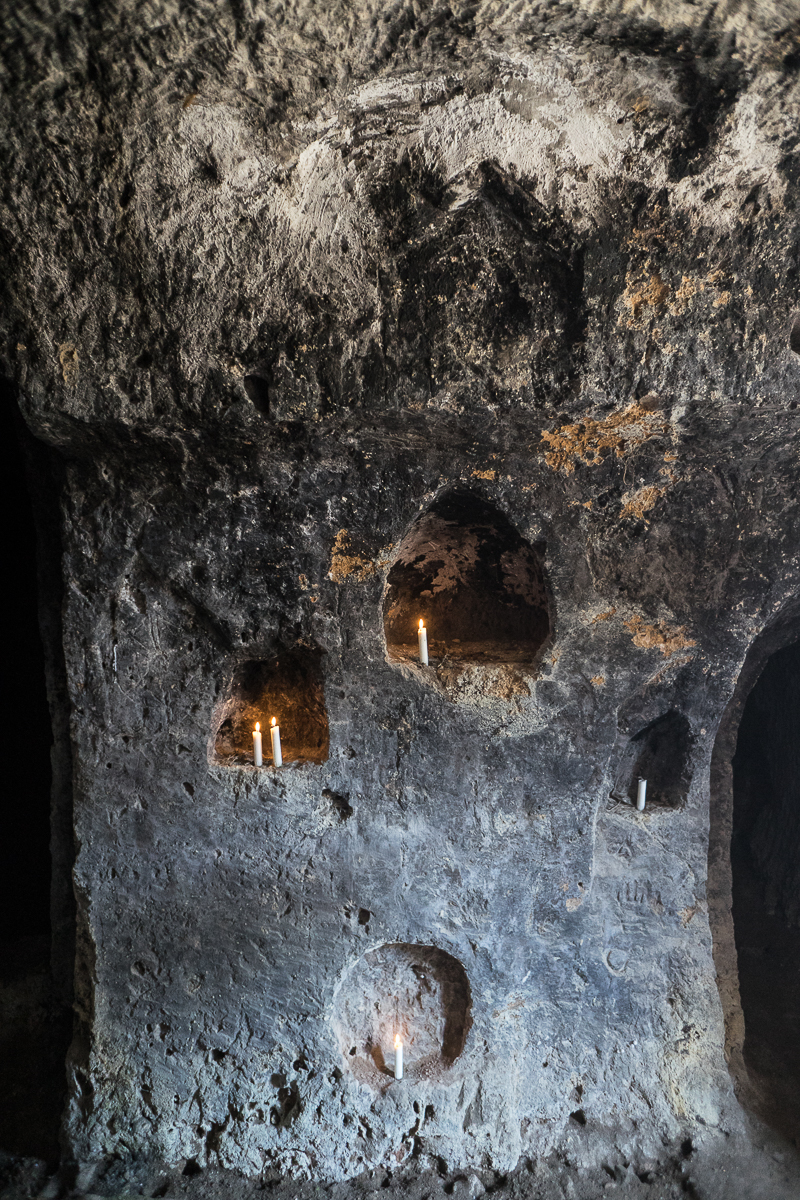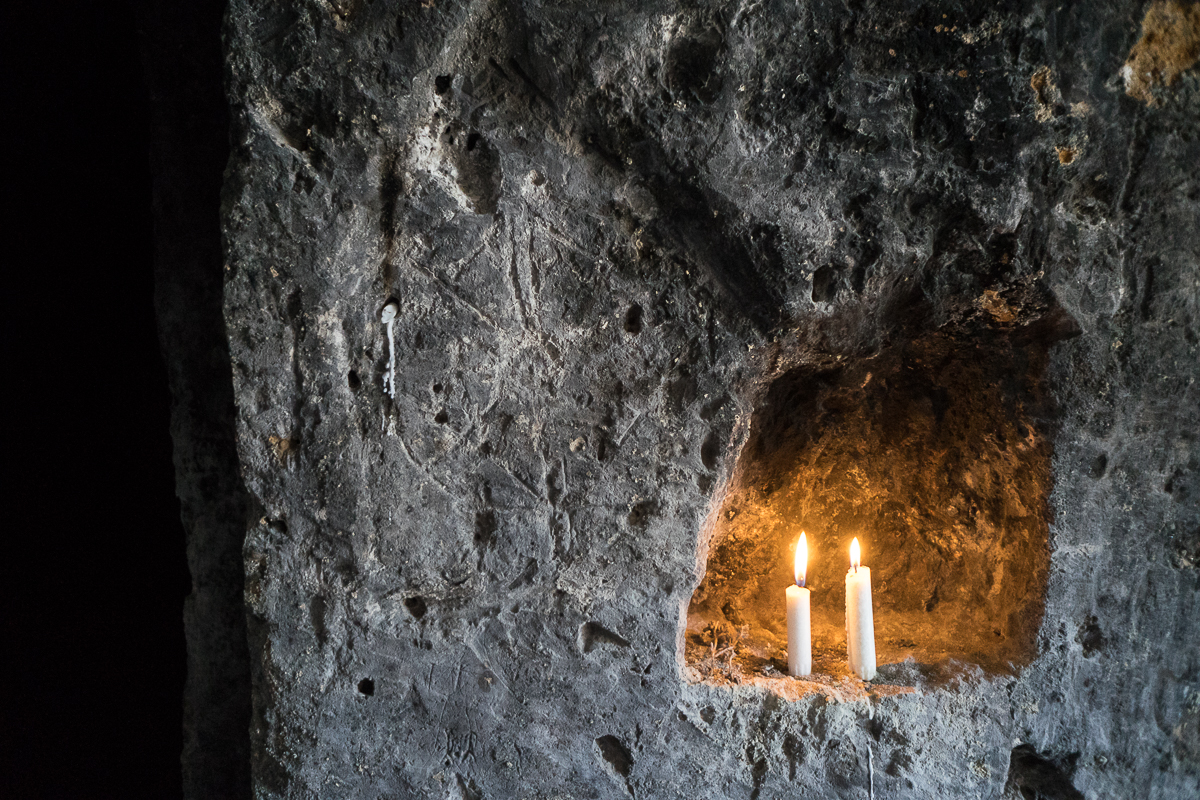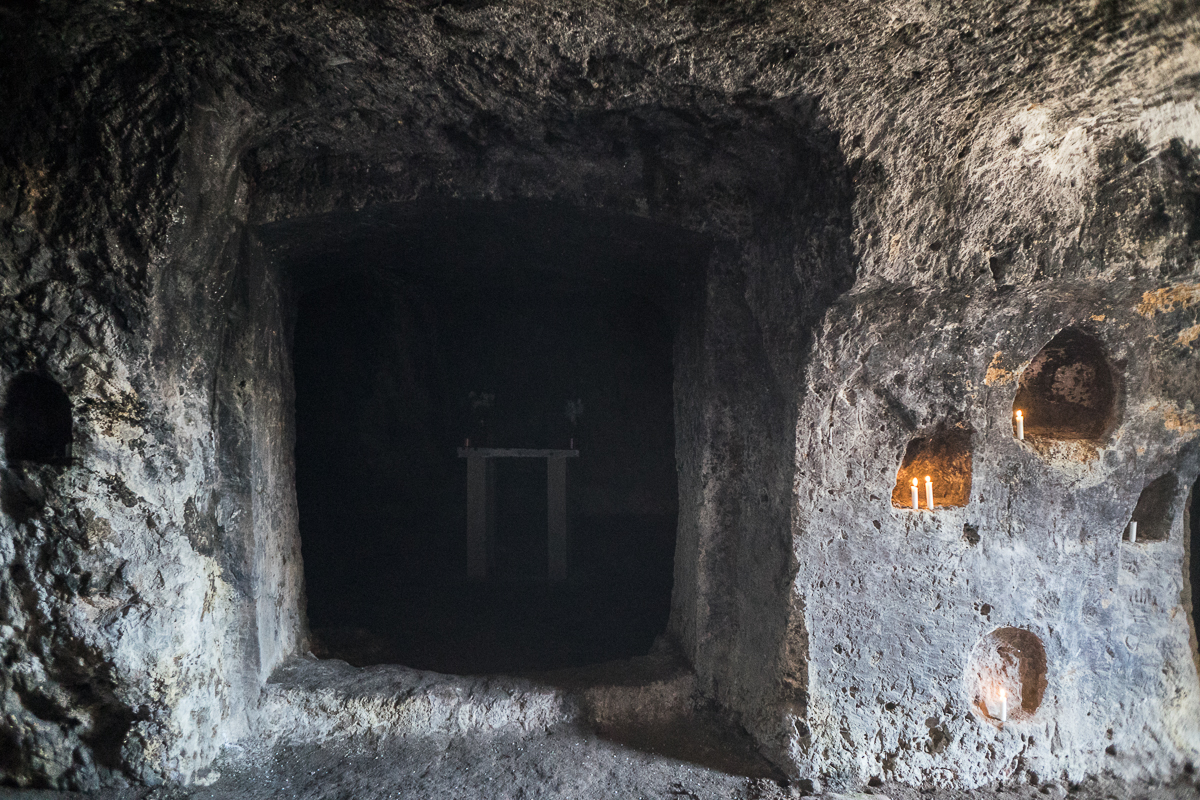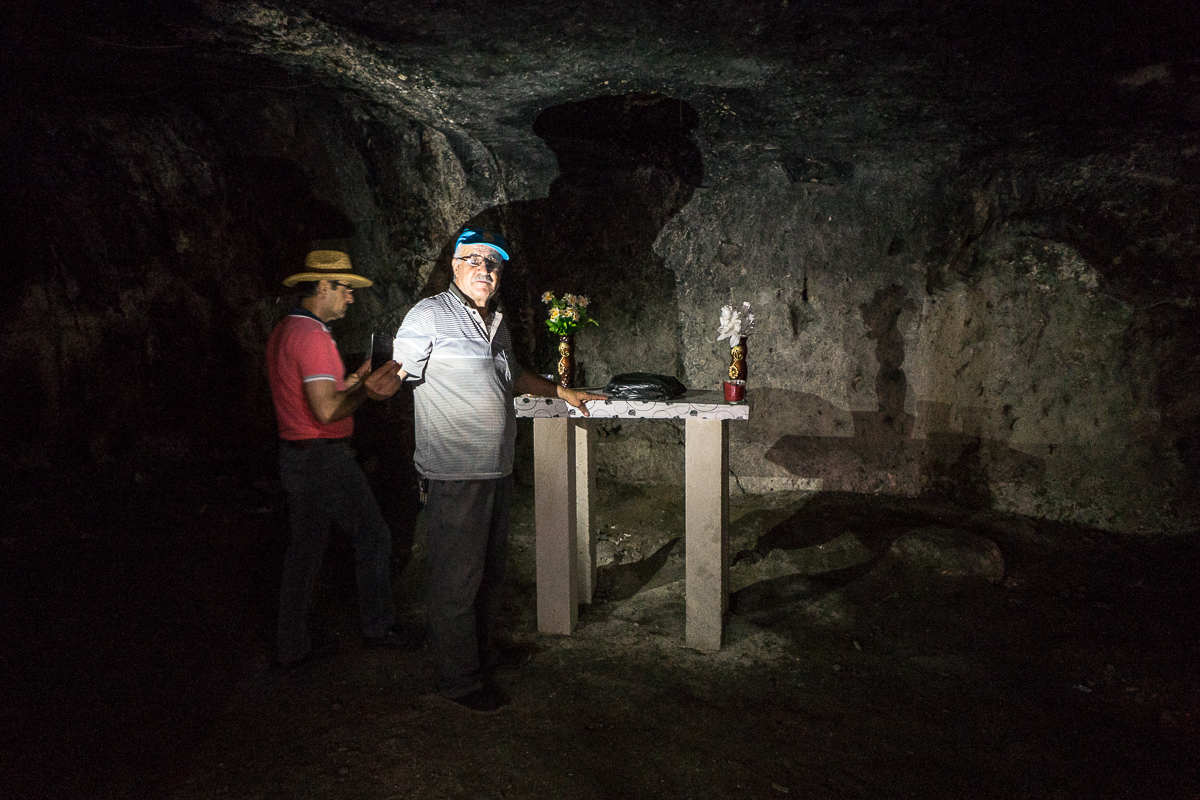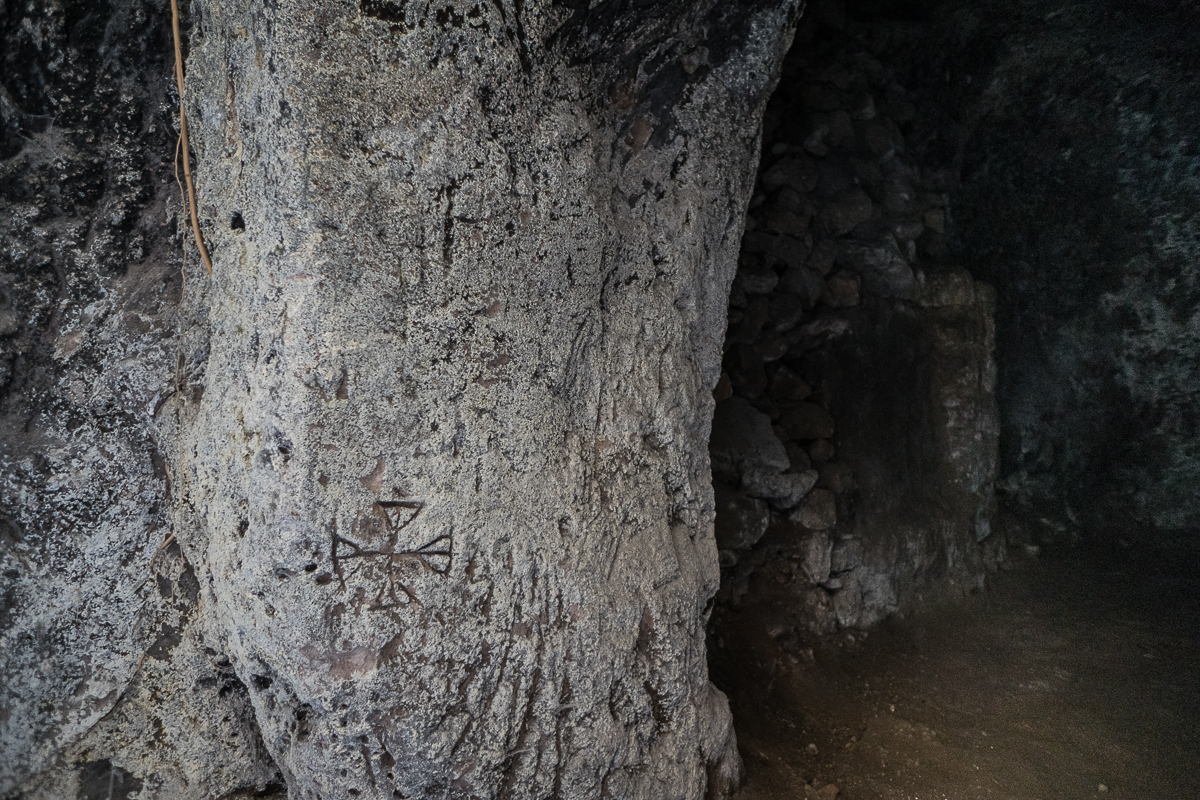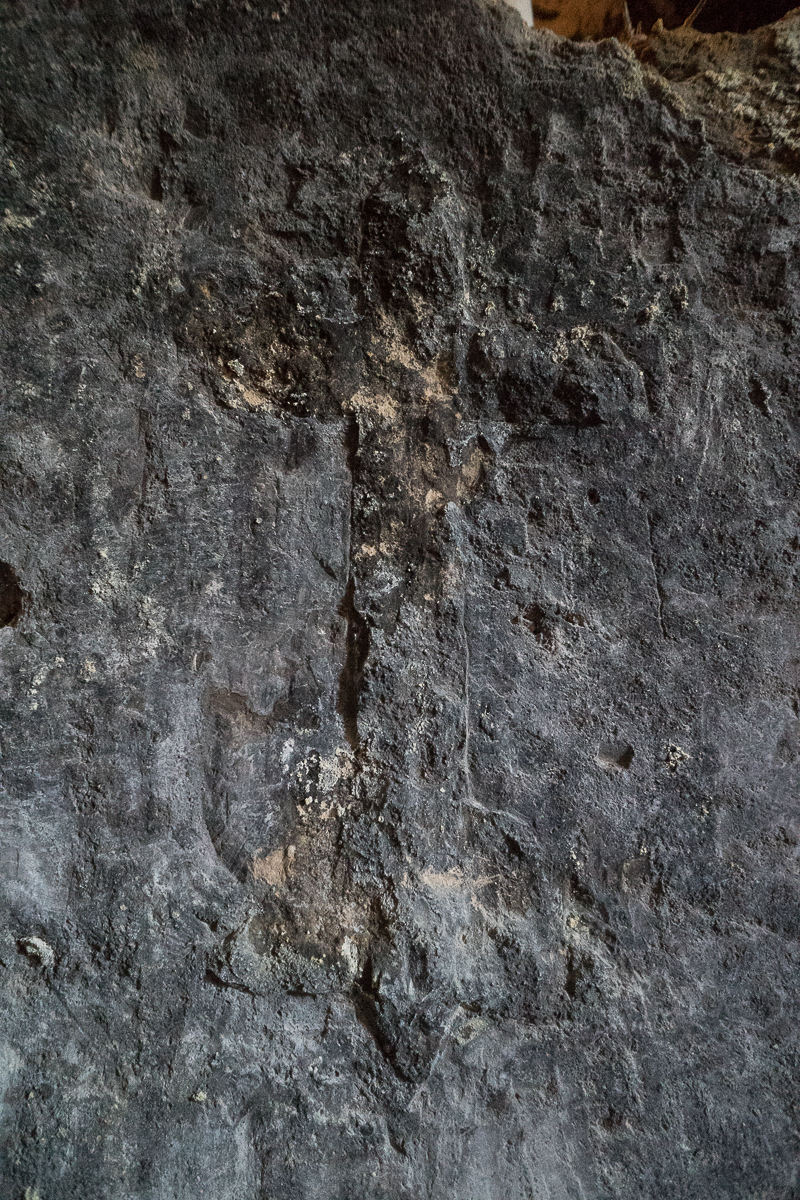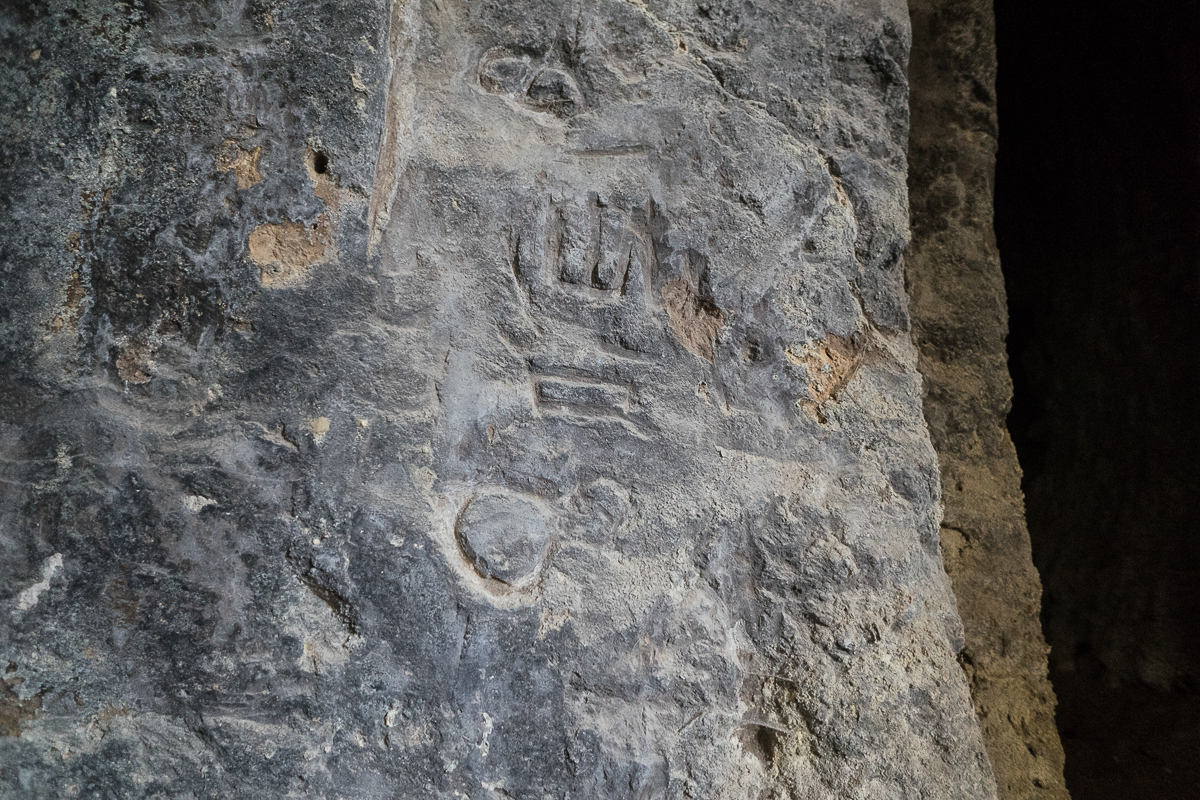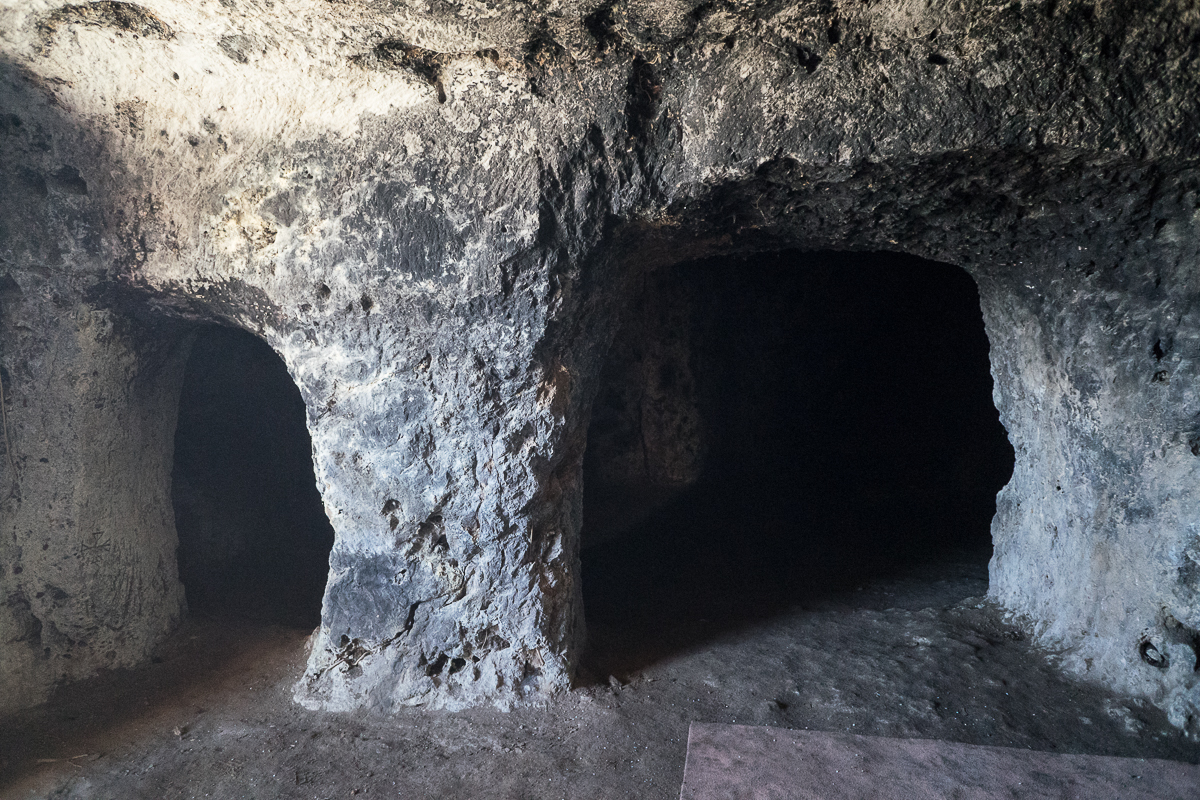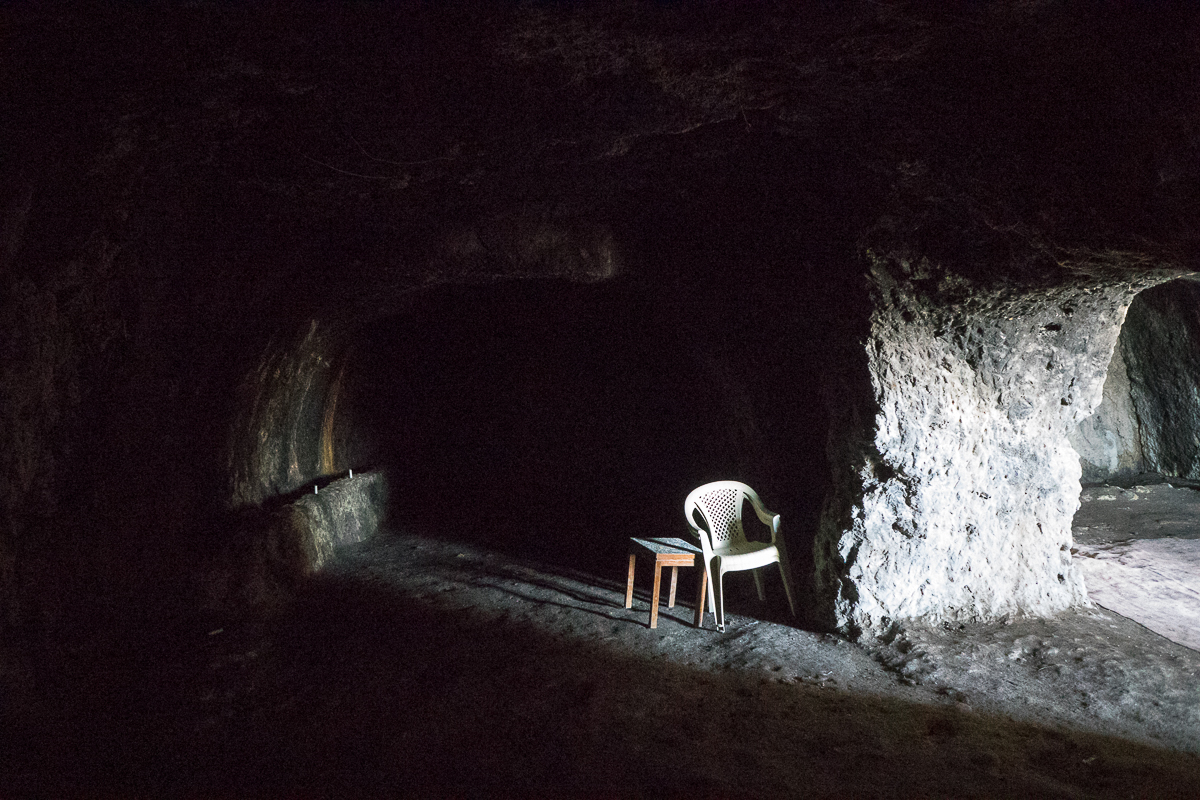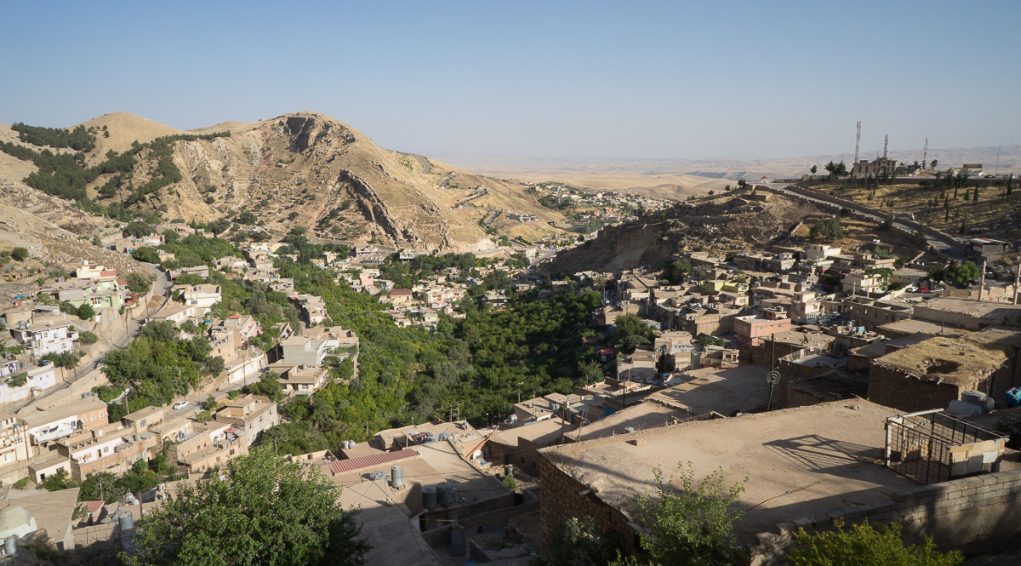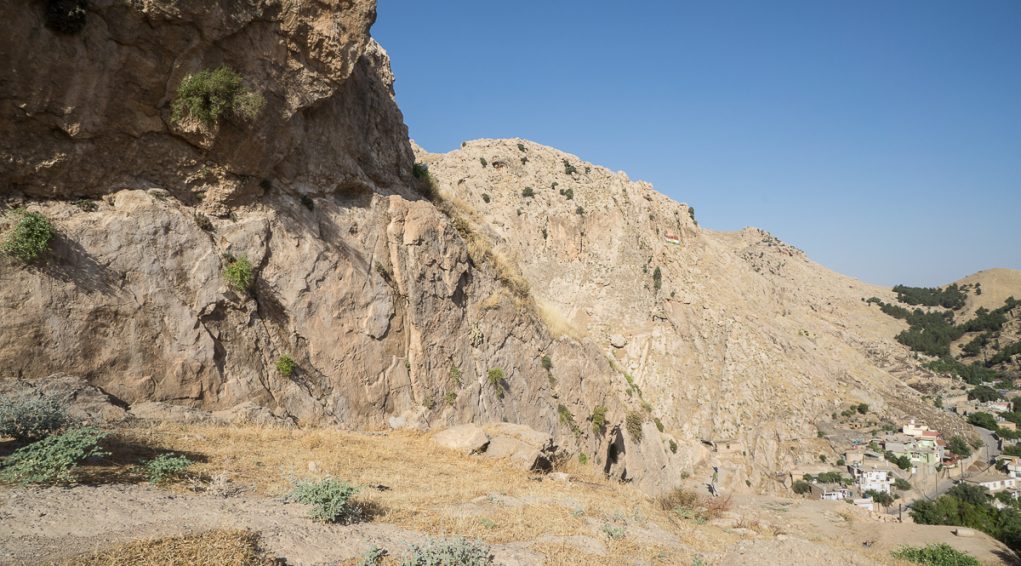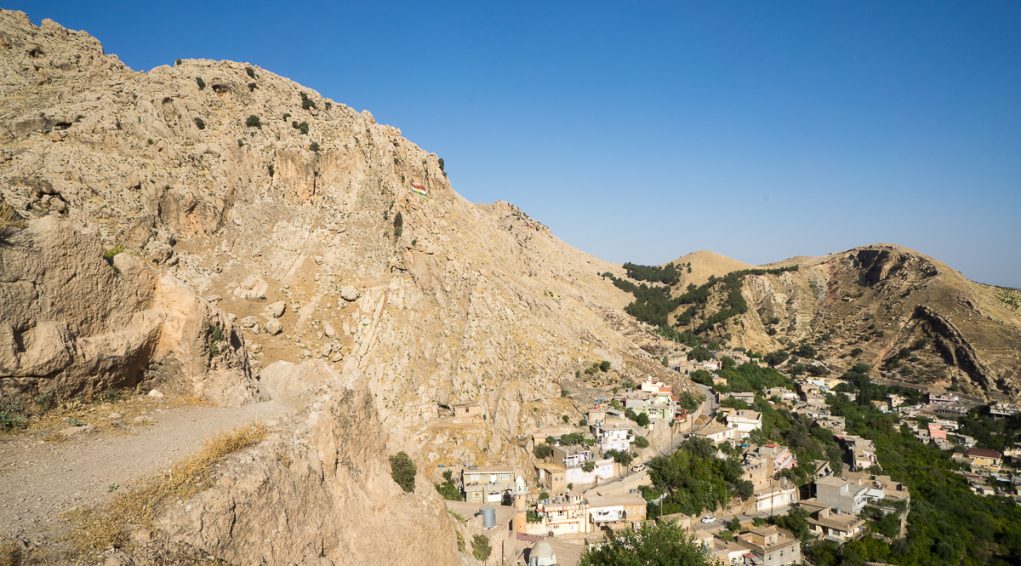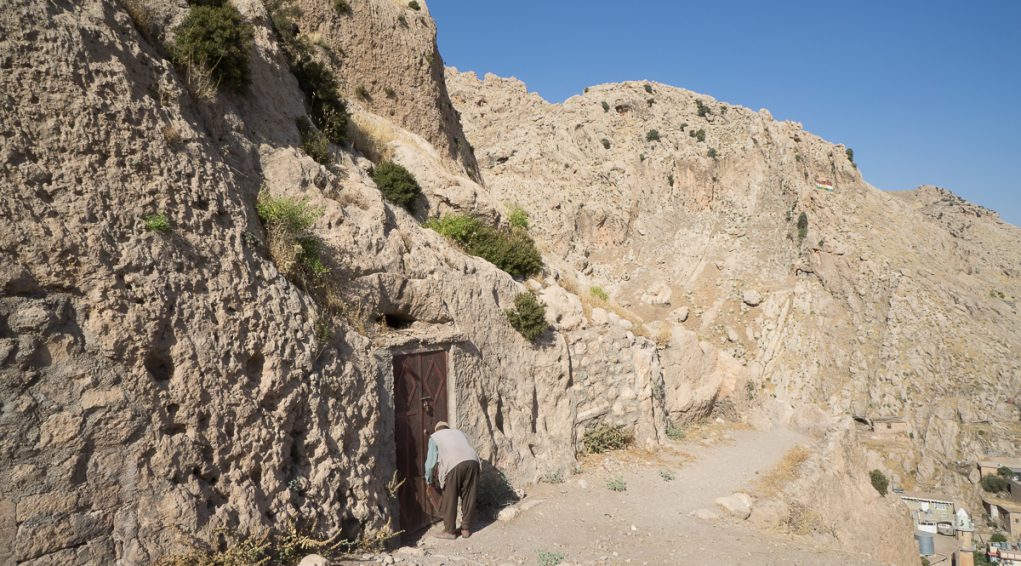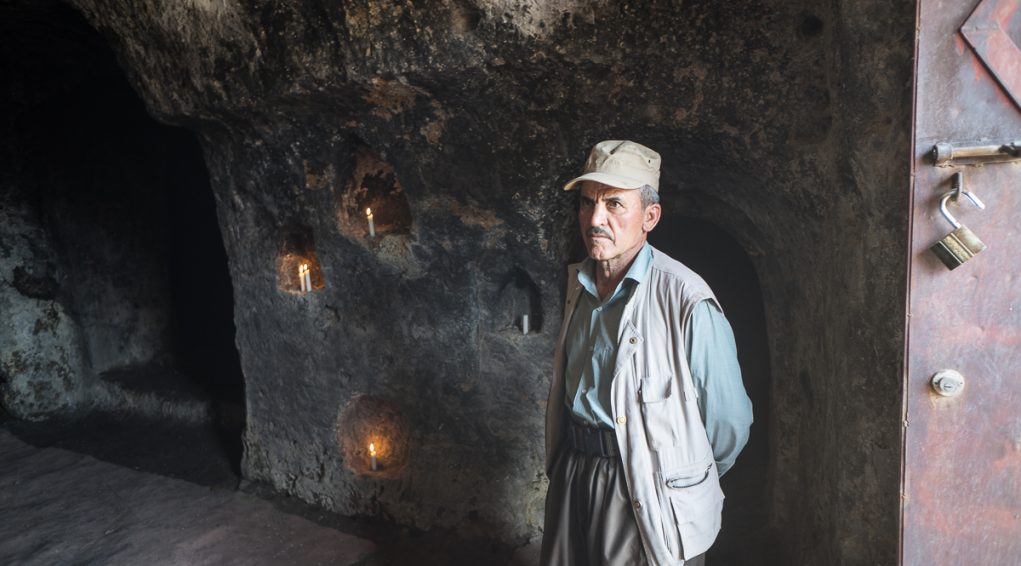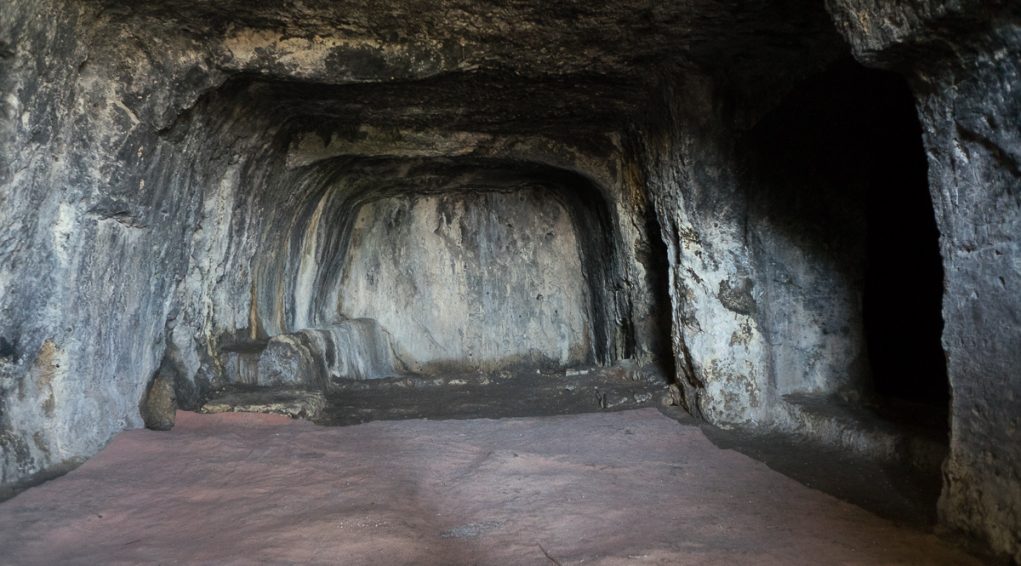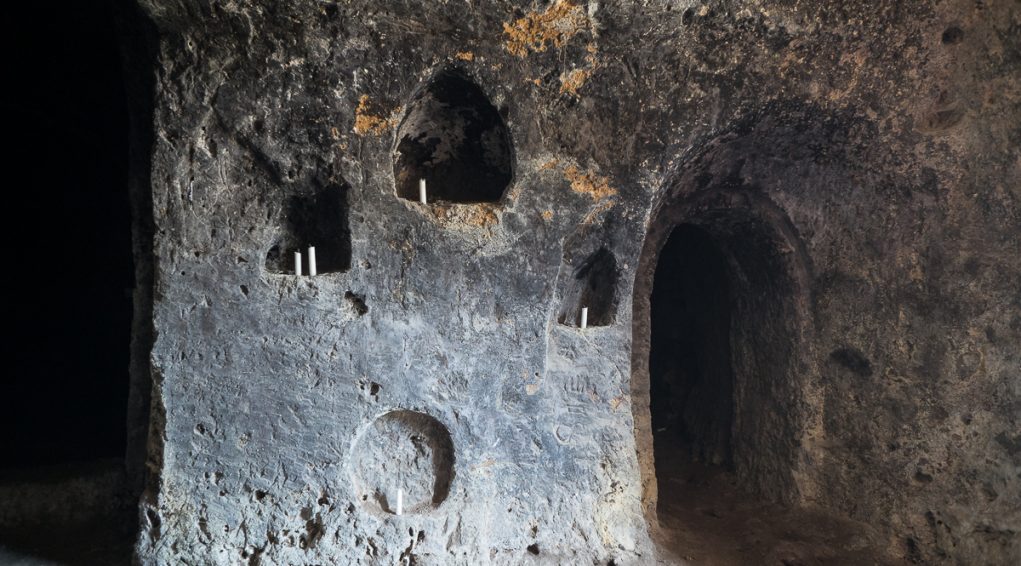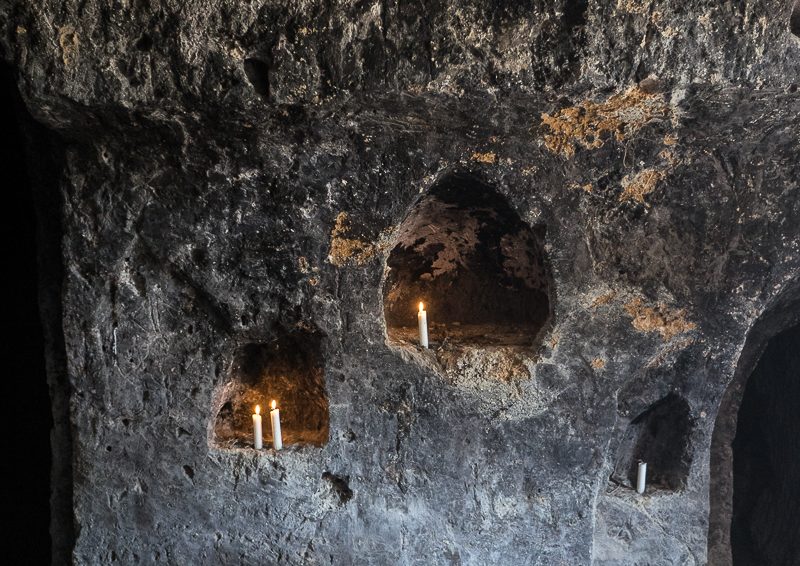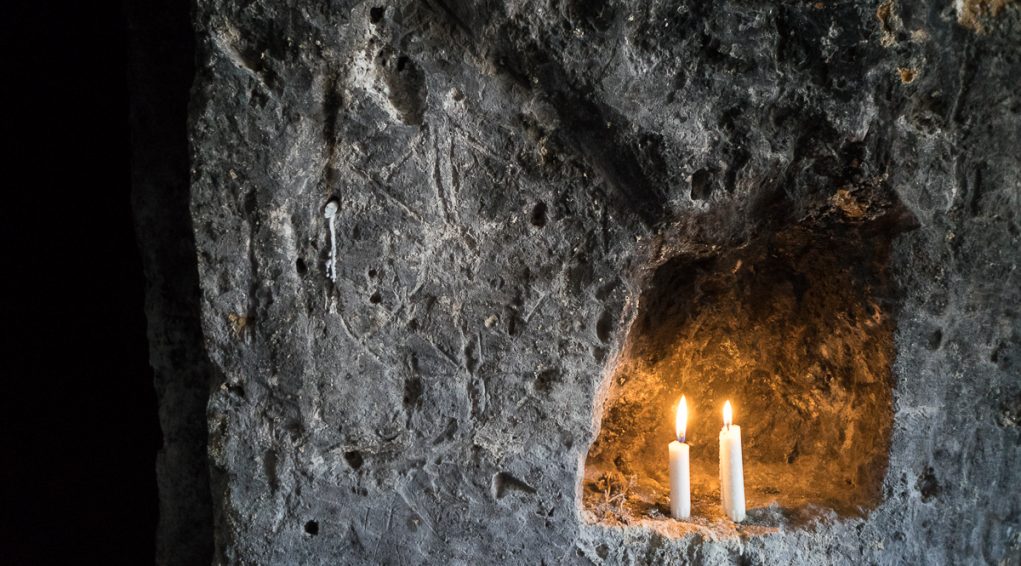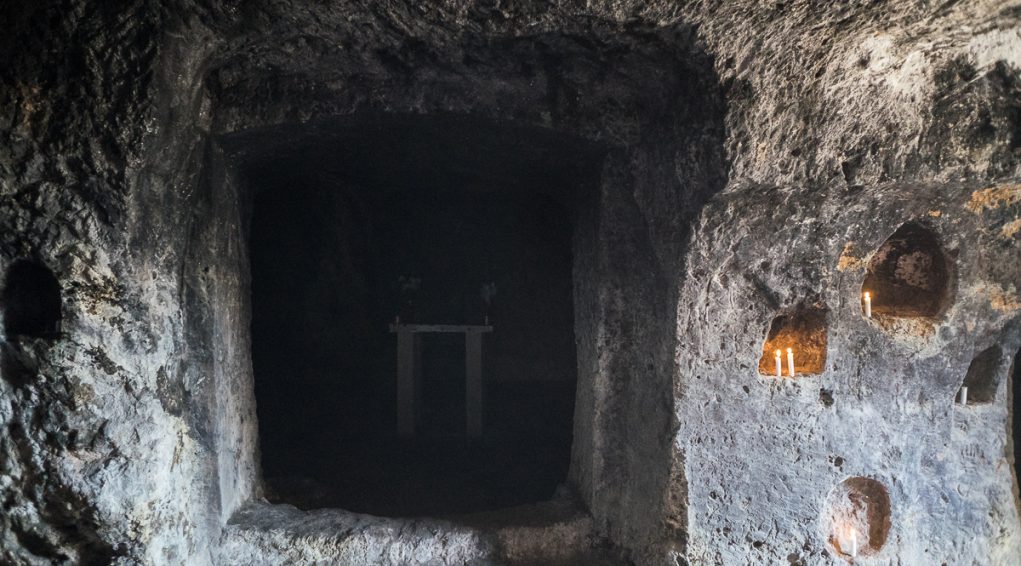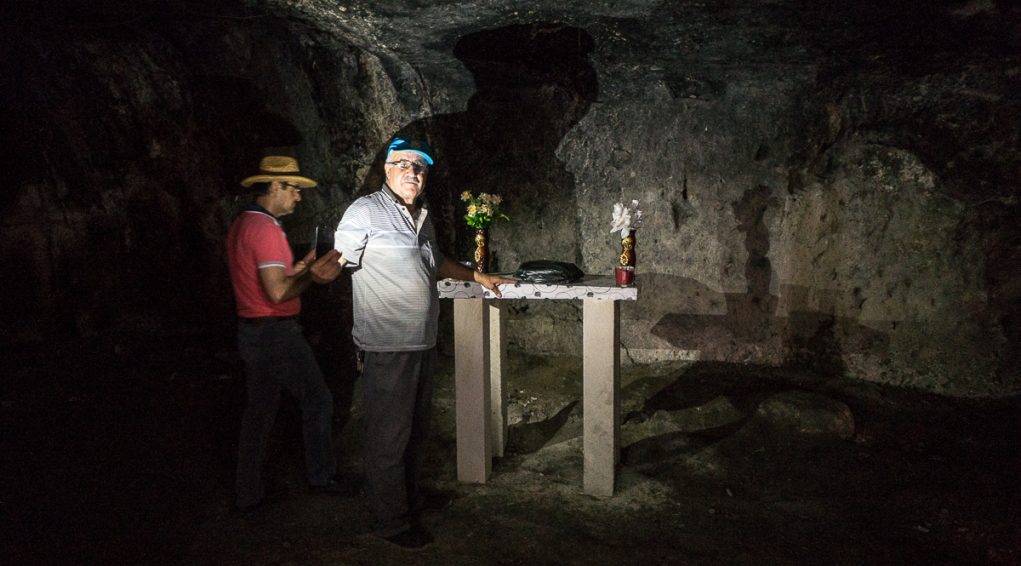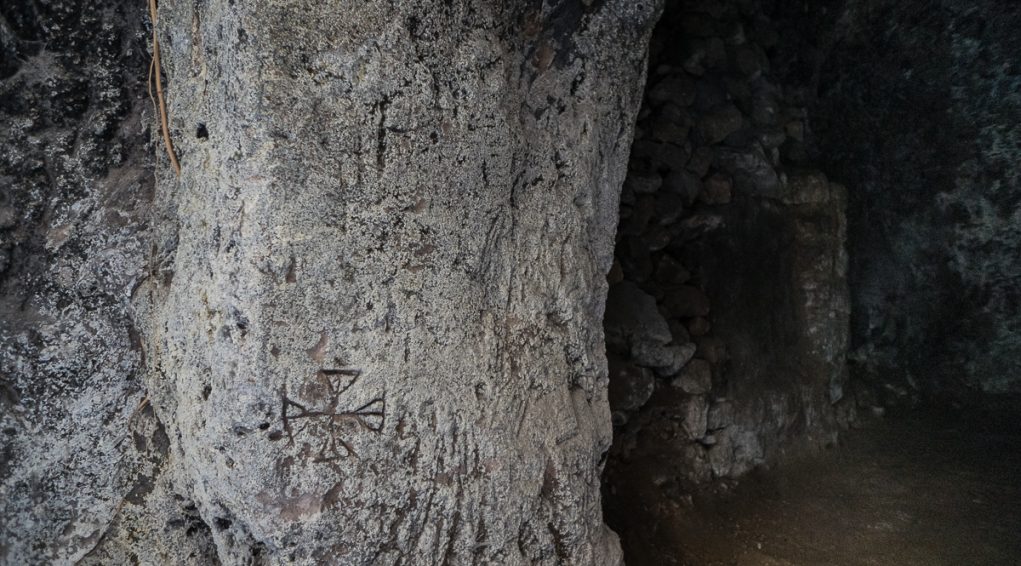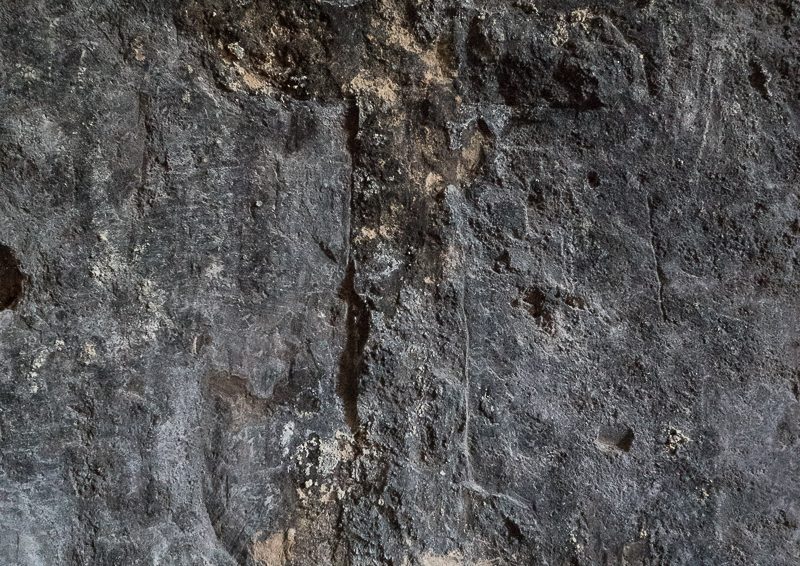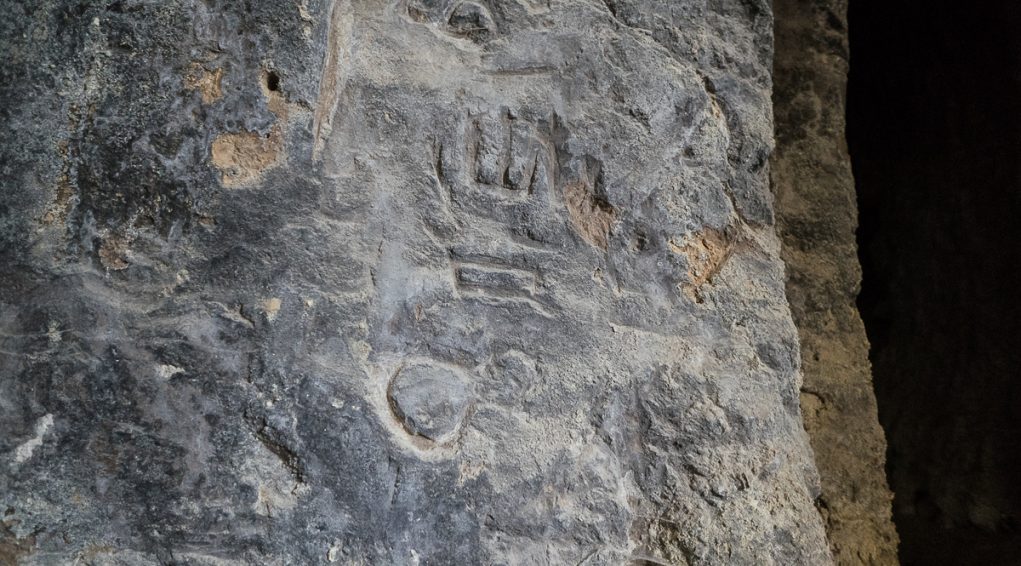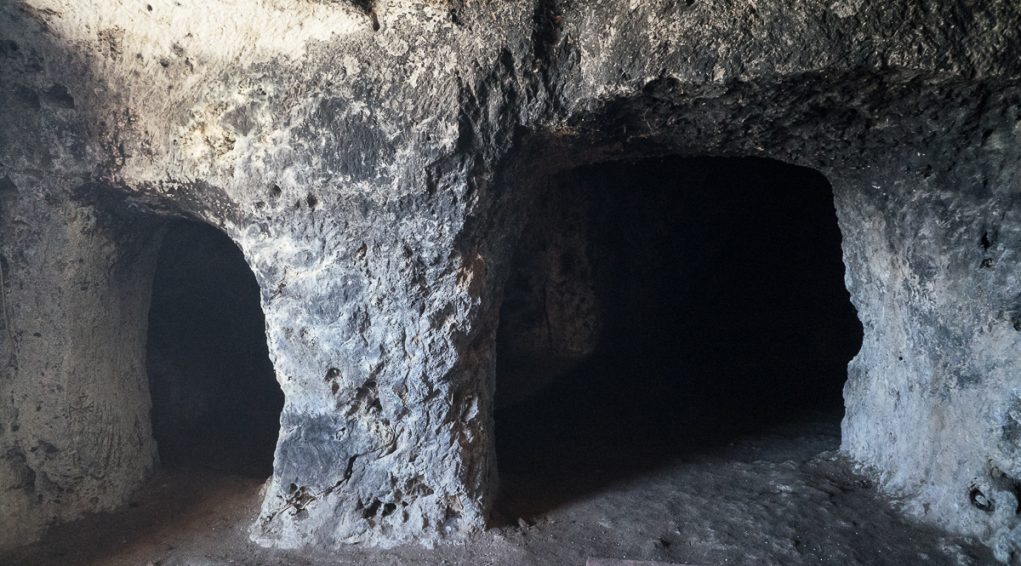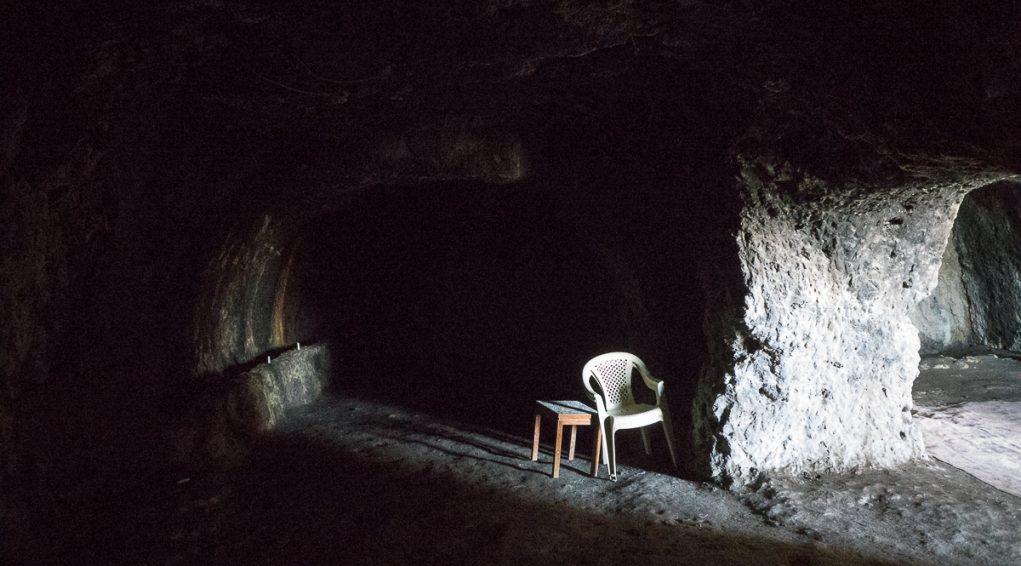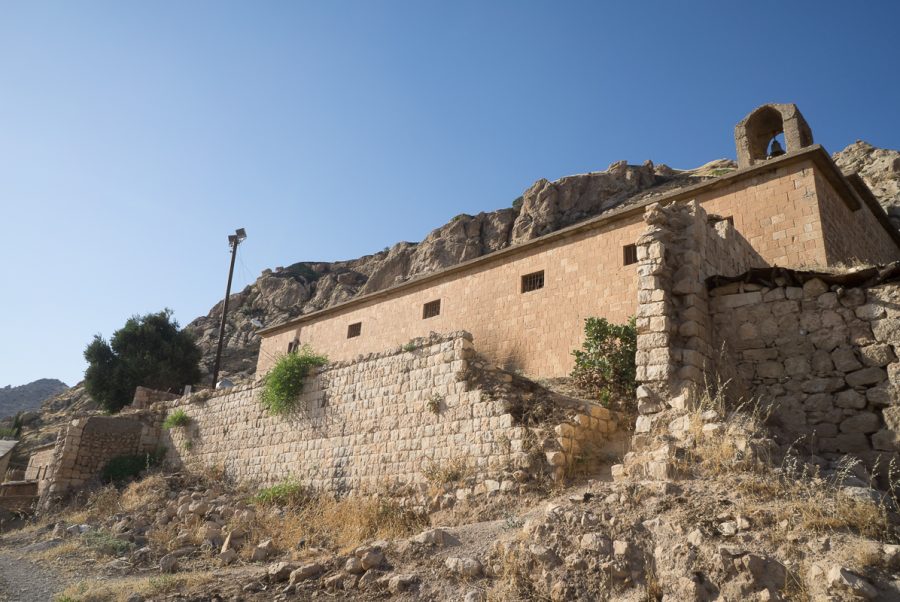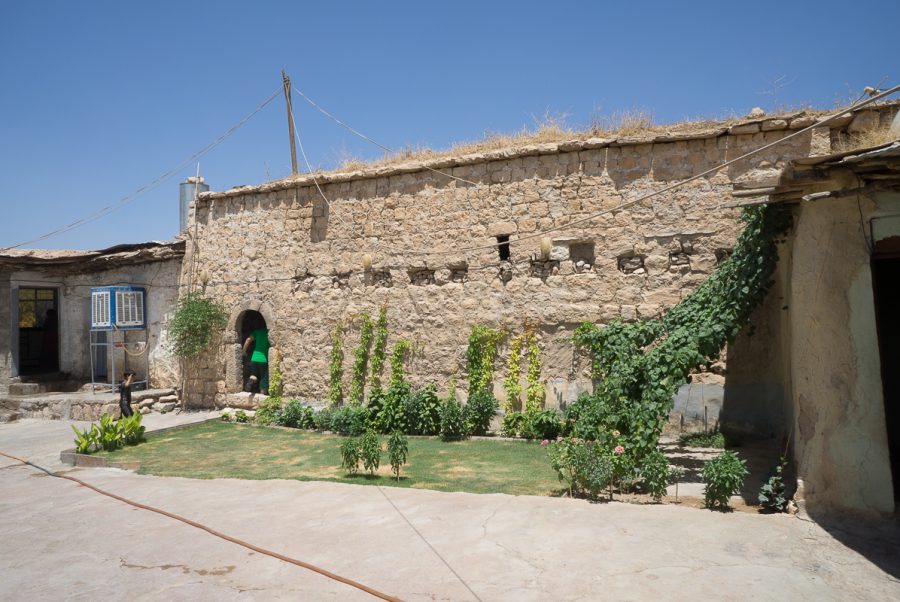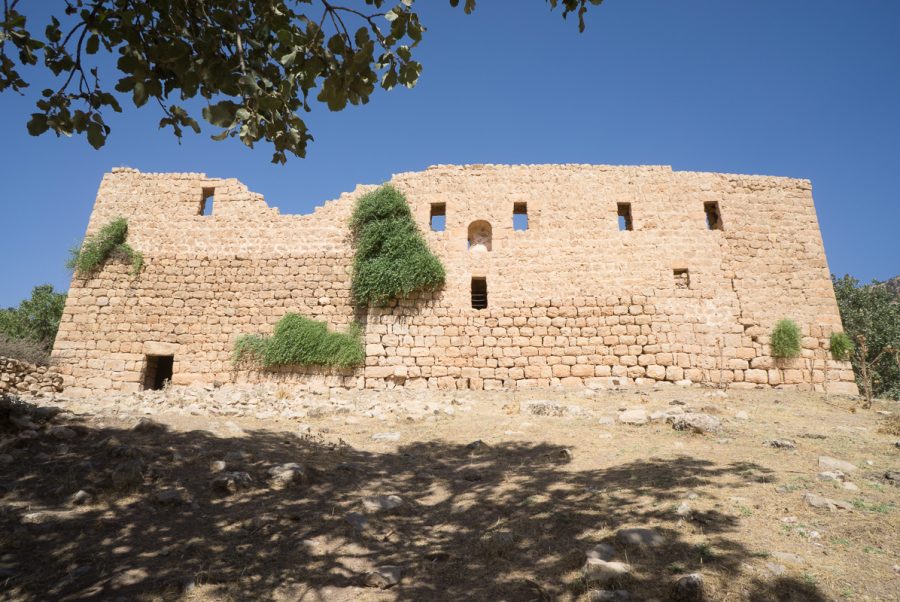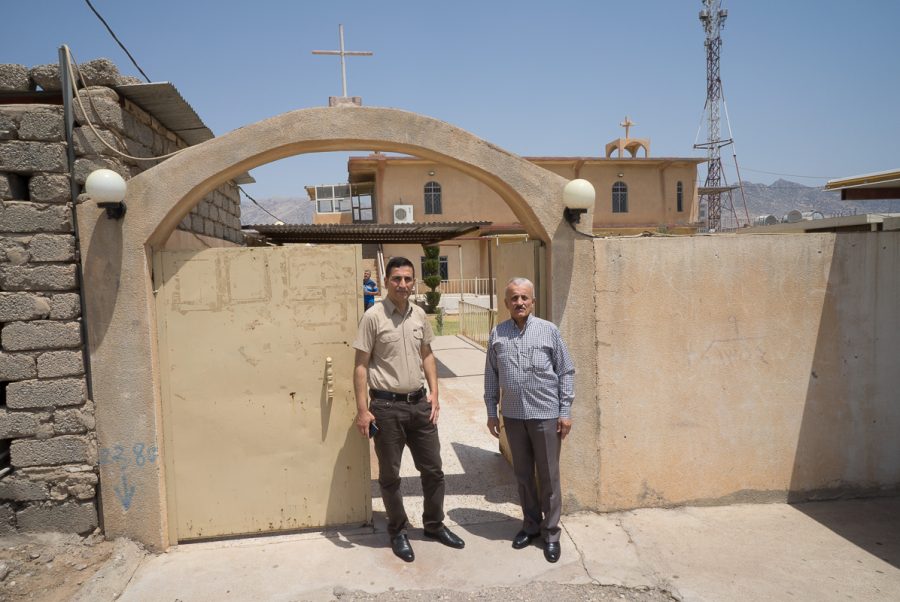The troglodyte Syriac-Orthodox Mar Gorgis Church in Aqrah
The troglodyte Syriac-Orthodox Mar Gorgis church in Aqrah is located at 36°45’38.9″N 43°53’44.2″E and 808 metres altitude.
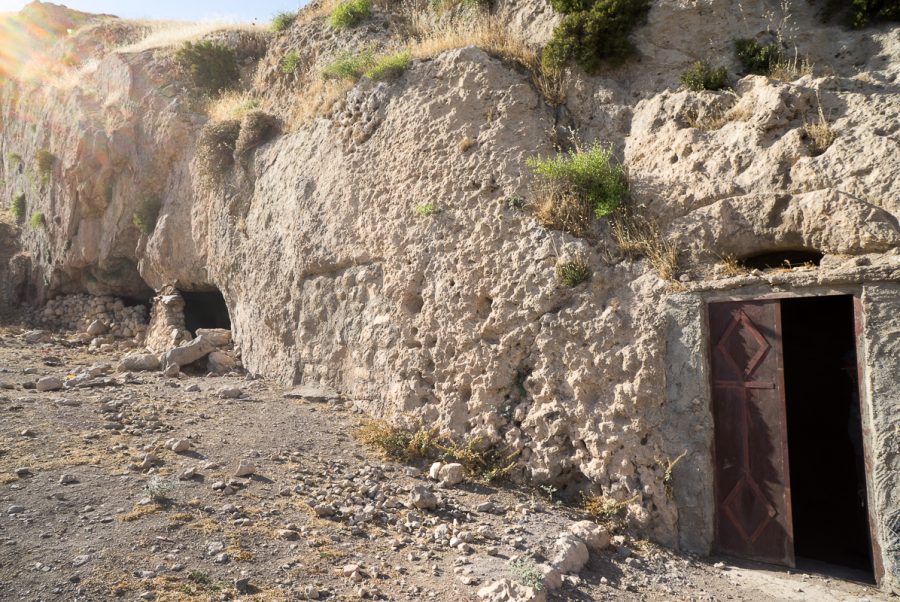
Situated just above the Mariam al Adra cathedral, the troglodyte Syriac-Orthodox Mar Gorgis church is cut into the cliff face which overlooks Aqrah. The panoramic view of the city and plain from the esplanade in front of the Mar Gorgis church is truly incredible. If you want to visit the church, as for the Mariam al Adra cathedral, you will need to ask the caretaker of the Muslim cemetery who has the key.
The church is composed of three parallel, communicating chambers dug into the rock. The three rooms are of approximately the same length and width.
We know absolutely nothing about the foundation of this troglodyte construction. Was it a place of Christian worship from the outset? Was it previously a Jewish or Assyrian place of worship? Was it even a religious space? Was it perhaps a community space, a refectory, a cellar?
Pic : The troglodyte Syriac-Orthodox Mar Gorgis church in Aqrah. July 2017 © Pascal Maguesyan / MESOPOTAMIA
Location
The troglodyte Syriac-Orthodox Mar Gorgis church in Aqrah is located at 36°45’38.9″N 43°53’44.2″E and 808 metres altitude. It is cut into the cliff face which overlooks the city of Aqrah.
Aqrah[1], to the west of Great Zab backs onto the mountain range of Chindar which borders Iraqi Kurdistan. The city is also 96 km to the east of Dohuk-Nohadra and 80 km north of Erbil.
Aqrah is an extremely ancient city, built on the terraces in the cliff face which overlooks the ancient citadel destroyed in 1840. There are also numerous gardens and waterfalls, as well as ancient traditional houses built of stone and earth.
_______
Fragments of Christian history
According to the tradition, the origin of the Church of the East goes back to the apostles and evangelizing preachers like Thomas, Addai (some assert that Addai is also the disciple Thaddeus, also known as Jude) and Mari. The new religion would have been preached specifically to local Jewish communities. The city of Aqrah is known for having a thriving Jewish community up until the 1940s, of which numerous traces of its heritage remain.[1]
This Christianity born out of this apostolic tradition, spread around Mesopotamia during the three first centuries, but it is really from the 4th century on and with the large number of martyrs persecuted by the Persian king Shapur II, that the Assyrian Church of the East really stepped into local history.
Over the centuries, the mountains which used to be very difficult to access were a place of fulfilment and protection for the Church of the East. The region of Aqrah, known as the province of Margā, was home to some of the most influential monasteries of the Church of the East, such as the Rabban Bar ‘Idtā monastery, as well as the Mar Ya’qōb de Bet‘Ābe (Beth’ Abhé)[2]the history of which was written by the illustrious 4th century monk and bishop Thomas de Marga, and which we know was built at the end of the 6th century at the latest. Thanks to the The Book of Governorsby Thomas of Marga there is a rich vein of historic documentation on the Church of the East between the 6th and 9th centuries[3]. In the 9th century there were more than twenty monasteries in the province of Marga. At the start of the 17th century, only four monasteries were mentioned in the region of Aqrah, with around sixty Church of the East Christian villages.
The Syriac-Orthodox church also laid roots in these mountains to the north of Mesopotamia in the 4th and 5th centuries. It developed a vast network of monasteries around the Mar Matta monastery on mount Maqlūb, which is said to have been home to thousands of monks and was known as the “Mountains of Thousands”. The influence of these Syriac-Orthodox monks and preachers stretched out across the Nineveh plain, in particular around Bartella and Mosul, setting up dynamic Christian communities wherever they went and building churches.
The Catholic, specifically Dominican, missions flourished here from the 18th century onwards and converted numerous local Christian communities to Catholicism, which moved from the Church of the East to the Chaldean church, and from the Syriac-Orthodox church to the Syriac-Catholic church, mainly from the start of the 19th century. Up until 1850, Aqrah, Zakho and Amadia formed one single Chaldean diocese called Amadia. It was at this time that they were divided into three separate archdioceses and the diocese of Aqrah was created.[4]
At the start of the 20th century, on the eve of the First World War, Aqrah was the capital of the Ottoman cazain the vilayet of Mosul. The circumstances of the Christians in the most remote regions of the Empire worsened in the 19th century, mainly due to the raids perpetrated by the Kurds, and became catastrophic during the genocide of the Armenians, Assyrians, Chaldeans and Syriacs in the Ottoman Empire from 1915-1918.
The rest of the 20th century was not much better for the Assyrian-Chaldeans from the mountains of Iraqi Kurdistan. Between 1961 and 1991, the successive wars which opposed the Iraqi government and the Kurdish peshmerga weighed heavily on the Christian communities and their heritage in these regions which were frequently bombed, notably with chemical weapons, where the populations were evacuated on several occasions and access was prohibited for a long period of time.
In the 21st century, the ISIS offensive on the Nineveh plain in August 2014, forced hundreds of Christian families to seek temporary shelter in Aqrah.
_______
[2]This monastery is next to Aqrah.At the end of the 19th century, the geographer Vital Cuinet saw only a few ruins. See “La Turquie d’Asie. Géographie administrative. Statistique descriptive et raisonnée de chaque province de l’Asie-mineure », second tome. Ernest Leroux publisher, Paris, 1891, p.844-845.
[3]In “The ecclesiastical organisation of the church of the east, 1318 – 1913”, David Wilmshurst, Éditions Peeters (Louvain), 2000, p.155
[4]In “L’Église chaldéenne catholique, autrefois et aujourd’hui”.Extract from the Annuaire Pontifical catholique de 1914, Abbé Joseph Tfinkdji, Chaldean Priest in Mardin, p.70
Christian demographics of Aqrah
At the end of the 19th century, from 1890-1891, there were 4,700 inhabitants in Aqrah, including 4,150 Muslims, 300 Israelites[1]and 250 Christians (Chaldeans and Jacobites[2]). The Chaldeans had small school of 15 pupils: “The schools in the mountains are the most basic facilities you can imagine. The schoolhouse is the church. The children sit along the wall, on mats and the teacher stands in the middle.”[3]The Syriac-Orthodox had no school and no priest.
Beyond the city limits, in the cazaof Aqrah, there were 81 villages for 11,000 inhabitants: 10,150 Muslim Kurds, 550 Chaldean and Jacobite Christians and 300 Israelites.
In 1913, the demographics had hardly changed. In Aqrah there was still a Christian community of 250 people (mainly Chaldean), with two priests, a church and a school[4]. This statistic was the same in 1961[5]before the start of the war between the Kurds and the government in Baghdad. The Christians in Aqrah, temporarily left the city in 1963 under the fire of the invading Arab forces. They were joined in the 1980s by Assyrian Christian families from the high plateaus of Nahla, whose 7 villages were destroyed and burned by Saddam Hussein. At the start of the 21st century, a new Christian community formed in Aqrah made up of the displaced people from the Nineveh plain who arrived in August 2014, fleeing the ISIS offensive. Of the 500 – 600 displaced families, only 100 remained in July 2017. This figure will no doubt have continued to decrease.
_______
[1]Israelite was the name used to designate Jews at this time.
[2]The Jacobites are part of the Syriac-Orthodox church.
[3]See “La Turquie d’Asie. Géographie administrative. Statistique descriptive et raisonnée de chaque province de l’Asie-mineure », second tome, Vital Cuinet. Ernest Leroux publisher, Paris, 1891, p.843.
[4]In L’Église chaldéenne catholique, autrefois et aujourd’hui, Abbé Joseph Tfinkdji, 1913, Extract from the Annuaire Pontifical Catholique from 1914, p. 51
[5]In “Assyrie Chrétienne”, vol II, Imprimerie catholique de Beyrtouth, J.M.Fiey, 1965, p.266
History of the troglodyte Syriac-Orthodox Mar Gorgis church in Aqrah
Towards the end of the 19th century, the Syriac-Orthodox in Aqrah met together and worshipped in a “sort of chapel or cave dug into the rock, in a similar way to those of the early Christians”[1], the troglodyte Mar Gorgis church above the Mariam al Adra cathedral. The Mar Gorgis church is also known locally as Aškafi Miryam.
We know absolutely nothing about the foundation of this troglodyte construction. Was it a place of Christian worship from the outset? Was it previously a Jewish or Assyrian place of worship? Was it even a religious space? Could it even be a dwelling dug out in prehistoric times? Was it perhaps a community space, a refectory, a cellar, or all of the above?
_______
[1]See “La Turquie d’Asie. Géographie administrative. Statistique descriptive et raisonnée de chaque province de l’Asie-mineure », second tome, Vital Cuinet. Ernest Leroux publisher, Paris, 1891, p.844.
Description of the troglodyte Syriac-Orthodox Mar Gorgis church in Aqrah
Situated just above the Mariam al Adra cathedral, the troglodyte Syriac-Orthodox Mar Gorgis church is cut into the cliff face which overlooks Aqrah. The panoramic view of the city and plain from the esplanade in front of the Mar Gorgis church is truly incredible.
If you want to visit the troglodyte Syriac-Orthodox Mar Gorgis church, as for the Mariam al Adra cathedral, you will need to ask the caretaker of the Muslim cemetery[1]who has the key.
The church is entered by the only access door, a rusted metal, double leaf door.
The church is composed of three parallel, communicating chambers dug into the rock. The three rooms are of approximately the same length and width, around 12 metres long and 4 metres wide.
Aligned with the door, the first room is also the best lit. It is empty. At the back of this chamber, on the left against the wall, is a window well.
To the south-east of the cave, the second room forms the sanctuary. It contains a small altar on which candles and artificial flowers have been placed. Between the two rooms, the wall constitutes a royal door with two opening on which we can make out engraved crosses. Four niches have also been sculpted into the rock in which candles have been placed.
The third room occupies the north-east of the troglodyte space. It can be accessed by two passages. There are no sculptures or inscriptions. This room is empty. At the back of this chamber, on the left against the wall, is a window well.
_______
[1]The caretaker on the day Mesopotamia visited on 16th July 2017 was Mohammed Rejab.
Monument's gallery
Monuments
Nearby
Help us preserve the monuments' memory
Family pictures, videos, records, share your documents to make the site live!
I contribute